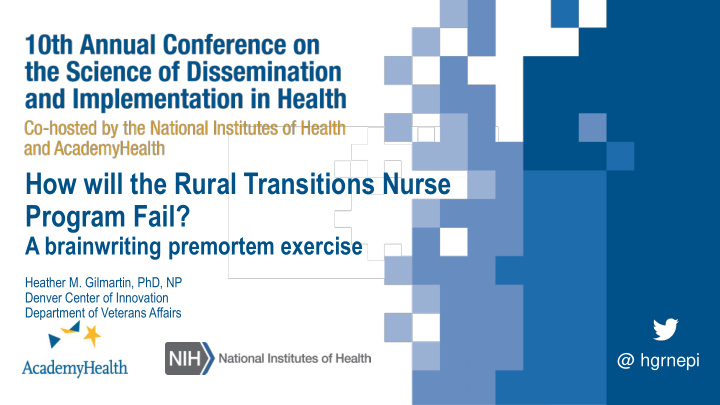



1 How will the Rural Transitions Nurse Program Fail? A brainwriting premortem exercise Heather M. Gilmartin, PhD, NP Denver Center of Innovation Department of Veterans Affairs @ hgrnepi
TODAY’S OBJECTIVES 2 Introduce the VA Rural Transitions Nurse Program Evidence-based implementation project Tour through development of brainwriting premortem Developed for pre-implementation site visits Present findings and next steps Brainwriting premortem protocol
DISCLAIMER 3 The contents of this presentation do not represent the views of the Department of Veterans Affairs or the United States Government Conflicts of Interest - None
ACKNOWLEDGEMENTS 4 A HUGE thank you to: Chelsea Leonard Robert Burke Brandi Lippman Andrew Coy Marina McCreight Michael Ho Ashlea Mayberry Lynette Kelley Emily Lawrence
D&I – STAFF ENGAGEMENT 5 D&I strategies must be sensitive to the context in which implementation efforts occur
6 VA RURAL TRANSITION NURSE PROGRAM Nurse-led intervention to improve transitions of care for rural Veterans
PREMORTEM 7 [pre mawr- tuh m] A method to identify threats and weaknesses in a project prior to implementation
PSYCHOLOGICAL SAFETY 8 [sahy-k uh -loj-i-k uh l / seyf-tee] The degree to which employees believe they will not be penalized for making errors, asking for help, or seeking feedback
BRAINSTORMING 9 [breyn-stawr-ming] Group of people gathered together to solve a problem with new ideas – a creative free for all
BRAINWRITING 10 [breyn-rahy-ting] The silent (non-verbal) written generation of ideas by a group
BRAINWRITING PREMORTEM 11
12 PRE-IMPLEMENTATION SITE VISITS 5 VA Hospitals 5 VA Primary Care Clinics 116 front-line clinicians Range: 4 – 26 clinicians
PERFORMANCE 13 Total barriers to implementation Original Ideas Ideas that received agreement Expanded ideas
BARRIERS IDENTIFIED 14
BARRIERS ADAPTATIONS 15 • Improved program Transition Nurse Role Definition materials Relationship with • Funding for site Primary Care visits to clinics Clinics
PARTICIPANT SATISFACTION 16 Satisfaction with group productivity Satisfaction with work processes No fear or worry when sharing ideas No fear or worry of criticism
FACILITATOR COMMENTS 17 Engaged participants Saw ‘aha’ Challenging to keep them on task moments Rich and ready Team building Venting session data
SUMMARY 18 Socially and cognitively stimulating Respectful Study limitations -- Lack of comparison
NEXT STEPS 19 Trial in diverse Create settings training Publish video findings and Train protocol Transition Brainwriting Nurses to Premortem facilitate sessions
REFERENCES 20 1. Brownson RC, Colditz GA, Proctor EK. Dissemination and implementation research in health: translating science to practice. New York: Oxford University Press 2012. 2. Creswell J. Research design: Qualitative, quantitative, and mixed methods approaches. 3rd ed. Los Angeles: Sage Publications 2009. 3. Liamputtong P. Focus group methodology: Principle and practice: Sage Publications 2011. 4. Kroll T, Barbour R, Harris J. Using focus groups in disability research. Qualitative Health Research 2007;17(5):690-98. 5. Hennink MM. International focus group research: A handbook for the health and social sciences: Cambridge University Press 2007. 6. Heslin PA. Better than brainstorming? Potential contextual boundary conditions to brainwriting for idea generation in organizations. Journal of Occupational and Organizational Psychology 2009;82(1):129-45. 7. Paulus PB, Yang H-C. Idea generation in groups: A basis for creativity in organizations. Organizational behavior and human decision processes 2000;82(1):76-87. 8. Thompson L. Improving the creativity of organizational work groups. The Academy of Management Executive 2003;17(1):96-109. 9. Paulus PB, Korde RM, Dickson JJ, et al. Asynchronous brainstorming in an industrial setting: Exploratory studies. Human factors 2015;57(6):1076-94. 10. VanGundy AB. Brain writing for new product ideas: an alternative to brainstorming. Journal of Consumer Marketing 1984;1(2):67-74. 11. Klein G. Performing a project premortem. Harvard Business Review 2007;85(9):18-19. 12. Kahneman D. Thinking, fast and slow: Macmillan 2011. 13. Klein G, Snowden D, Pin CL. Anticipatory thinking. KL Mosier, & UM Fischer, Informed by Knowledge 2011:235-46. 14. Michinov N. Is electronic brainstorming or brainwriting the best way to improve creative performance in groups? An overlooked comparison of two idea ‐ generation techniques. Journal of Applied Social Psychology 2012;42(S1) doi: 10.1111/j.1559-1816.2012.01024.x 15. Byron K. Creative reflections on brainstorming. London Review of Education 2012;10(2):201-13. doi: 10.1080/14748460.2012.691284 16. Feldstein AC, Glasgow RE. A practical, robust implementation and sustainability model (PRISM) for integrating research findings into practice. The Joint Commission Journal on Quality and Patient Safety 2008;34(4):228-43. 17. Thomas DR. A general inductive approach for analyzing qualitative evaluation data. American Journal of Evaluation 2006;27(2):237-46. 18. Beebe J. Rapid assessment process: An introduction. Oxford, England: AltaMira Press 2001. 19. Beck A, Bergman DA, Rahm AK, et al. Using implementation and dissemination concepts to spread 21st-century well-child care at a health maintenance organization. The Permanente Journal 2009;13(3):10. 20. Liles EG, Schneider JL, Feldstein AC, et al. Implementation challenges and successes of a population-based colorectal cancer screening program: a qualitative study of stakeholder perspectives. Implement Sci 2015;10(1):41.
21 THANK YOU! Heather M. Gilmartin, PhD, NP Denver Center of Innovation - Department of Veterans Affairs Heather.gilmartin@va.gov @ hgrnepi
Recommend
More recommend